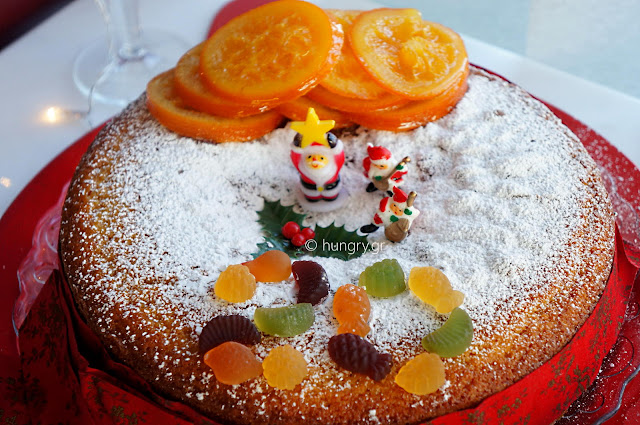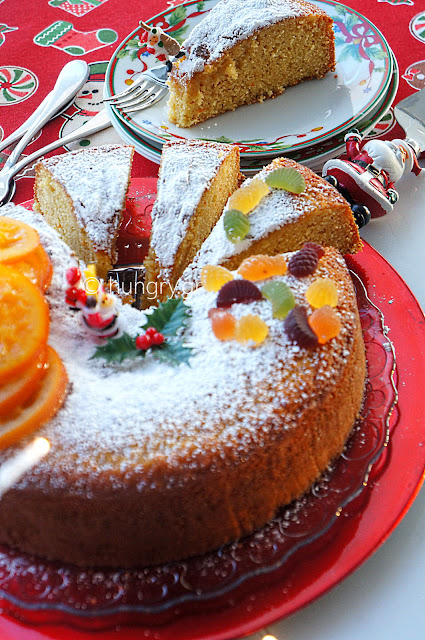
Ritual & Symbols
Vasilopita {Greek:Βασιλόπιτα, Vasilópita (St.Basil-pie)} is a New Year's Day bread or cake in Greece and many other areas in Eastern & Wester Europe and the Balkans which contains a hidden coin or trinket which gives good luck to the receiver. It is associated with Saint Basil's day, January 1, in most of Greece, but in some regions, the traditions surrounding a cake with a hidden coin are attached to Epiphany or to Christmas.
On New Year's Day families cut the Vasilopita to bless the house and bring good luck for the new year. This is usually done at midnight on New Year's Eve. A coin is hidden in the bread by slipping it into the dough before baking.
At midnight the sign of the cross is etched with a knife across the cake. A piece of cake is sliced for each member of the family and any visitors present at the time, by order of age from eldest to youngest. Depending on local and family traditions, slices are cut for various symbolic people or groups.
They may include the Lord, St. Basil and other saints, the poor, the household, or the Kalikantzaroi.
In older times, the coin often was a valuable one, such as a gold sovereign. Nowadays there is often a prearranged gift, money, or otherwise, to be given to the coin recipient.
The traditions surrounding Vasilopita are very similar to Western European celebrations of the Twelfth Night & Epiphany: the King Cake (Gâteau des Rois) of France and Louisiana and the Tortell in Catalonia.
Vasilopita {Greek:Βασιλόπιτα, Vasilópita (St.Basil-pie)} is a New Year's Day bread or cake in Greece and many other areas in Eastern & Wester Europe and the Balkans which contains a hidden coin or trinket which gives good luck to the receiver. It is associated with Saint Basil's day, January 1, in most of Greece, but in some regions, the traditions surrounding a cake with a hidden coin are attached to Epiphany or to Christmas.
On New Year's Day families cut the Vasilopita to bless the house and bring good luck for the new year. This is usually done at midnight on New Year's Eve. A coin is hidden in the bread by slipping it into the dough before baking.
At midnight the sign of the cross is etched with a knife across the cake. A piece of cake is sliced for each member of the family and any visitors present at the time, by order of age from eldest to youngest. Depending on local and family traditions, slices are cut for various symbolic people or groups.
They may include the Lord, St. Basil and other saints, the poor, the household, or the Kalikantzaroi.
In older times, the coin often was a valuable one, such as a gold sovereign. Nowadays there is often a prearranged gift, money, or otherwise, to be given to the coin recipient.
The traditions surrounding Vasilopita are very similar to Western European celebrations of the Twelfth Night & Epiphany: the King Cake (Gâteau des Rois) of France and Louisiana and the Tortell in Catalonia.
| εργασία: 20′ | χρόνος: 1h:20′ | εύκολο: |
★Click with your mouse on the pictures to learn more.



Announcement New Book Release
 With great pleasure we inform you that issued the New Book of Kitchen Stories titled «Μεζέδες». It includes a collection of 45 savory recipes for easy and practical everyday food solutions but also quick finger foods for festive table or buffet.
With great pleasure we inform you that issued the New Book of Kitchen Stories titled «Μεζέδες». It includes a collection of 45 savory recipes for easy and practical everyday food solutions but also quick finger foods for festive table or buffet.Excerpt from the introduction: «I often wonder what the culmination of cooking is. Are they the freshest ingredients, the most complex flavors are the everyday or the rare? They are nothing. Highschooling is neither eating nor cooking, but offering food and companionship…» Email Contact & orders: kitchenstories08@gmail.com or order online at amazon.

Ingredients (~12 servings)
|  At first we wash and wipe the oranges. Remove their zest and squeeze them to get their juice. In the standard mixer bowl pour the butter and beat it to whiten and soften. |  Add the sugar and the eggs, breaking them into a separate saucer one by one to control their freshness. Beat them for 6'-7' to whiten and inflate. |
 Add the baking powder & soda to the flour and sift it. Add the orange zest and ⅓ of their juice to the mixer bucket alternating with με ⅓ of the flour mixture. Pour the shotgun with the brandy. Continue hitting at low speed until the ingredients are finished. | 
Prepare your baking pan. First butter a pan with dimensions Ø26-28cm, so that the parchment paper sticks on it, then butter the parchment paper. Wrap a coin with foil and place it at the base of the pan near to the circumference. Place this amazing cake batter in the pan & pour into the oven. |
 Bake in preheated oven at 175℃, 347℉, Gas Mark:3.9 for ~1 hour. If it gets color fast we cover with foil, which we remove to the end. We try in the center of the Vasilopita with a skewer stick to come out clean.
Cool in tin for 10 mins before flipping onto a cooling rack. Sprinkle with powdered sugar and shape the year -2020- with mini fruit jellies. |




